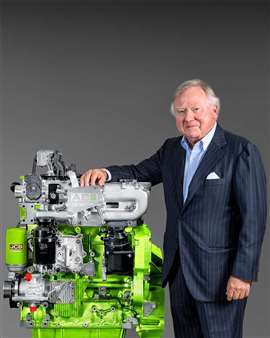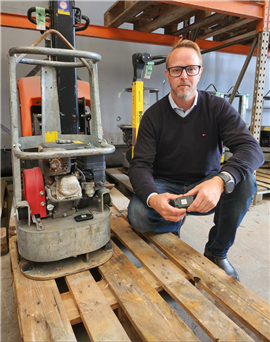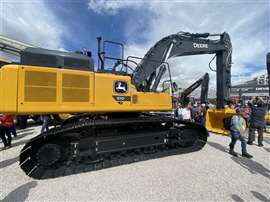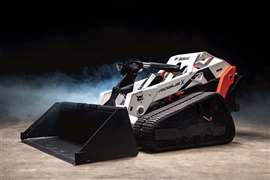The biggest developments in construction equipment in 2023
14 December 2023
The end of the year is an excellent time to look back, take stock and use that perspective to create a vision and a strategy for what’s next. Here we’ve gathered a collection of the some of most impactful developments in construction equipment over the past 12 months. While fascinating at face value, these reports are a reflection of the trends shaping our world and offer a blueprint for fleet and operational management going forward.
Several themes dominated construction equipment news this year, and a high-level look at the big picture suggests exciting times to come for machine owners and operators.
It’s not surprising that 2023 held so many reports of innovations and advancements - it was a ConExpo year after all, and contruction’s largest North American tradeshow never fails to yield a stunning list of important introductions and announcements. This year it was no different, and the industry’s leading suppliers of products and services did not disappoint.
This is by no means an exhaustive list, but it hints at the trends sweeping construction and adjacent industries: alternative power, operational digitalization, sustainability, autonomy and AI.
As 2023 comes to a close, take a look back at the year’s advancements before turning your sights to what comes next. These are exciting times, both from a technological standpoint, but also in the rapidly changing ways in which we do business.
Alternative power dominates discussion
 JCB Chairman, Lord Bamford, with the company’s hydrogen combustion engine unveiled at ConExpo this year.
JCB Chairman, Lord Bamford, with the company’s hydrogen combustion engine unveiled at ConExpo this year.
JCB unveils hydrogen engine - JCB has put a great deal of commitment behind its hydrogen combustion technology, putting its team of engineers on the task of developing a hydrogen internal combustion engine and prototype backhoe-loader and telescopic hander for it to power.
The “first-principles hydrogen combustion solution” shares roughly 70% of its DNA with its diesel brethren.
“Essentially, from the top of the block down… it’s exactly the same characteristics so the engine gives the same output,” Tim Burnhope, chief innovation and growth officer at JCB said earlier this year. “What we’ve done really is take off today’s combustion process and put a new combustion process on the top.”
JCB showcased its hydrogen combustion technology on the international stage with a debut in North America at ConExpo, where attendees were show able to see the zero-emissions engine for the first time.
Cummins introduces fuel-agnostic 15-liter engine - Cummins unveiled its new 15-liter, fuel-agnostic engine, a single-platform design capable of supporting various fuel types, including hydrogen, natural gas and diesel.
“Cummins’ all-new platform takes internal combustion to a new level, capable of meeting future ultra-low emission standards, such as EPA Tier 5 and EU Stage 6, together with a low-to-zero carbon fuel capability to help put construction and quarrying sites on a lower cost path to decarbonization,” said Antonio Leitao, VP Global Off-highway Engine Business.
The new engine is ‘clean sheet’ design that Cummins states ‘points to the future of diesel,’ offering more capability and less environmental impact. The engine’s high power density is intended to set the standard for heavy-duty performance in key off-road applications, including excavators, wheel loaders, drilling rigs and haul trucks.
Battery Energy Storage Systems (BESS) take center stage - Volvo Penta announced in April the expansion of its power generation business into battery energy storage systems (BESS) for original equipment manufacturers (OEMs). Volvo Penta’s modular and scalable solution is intended for integration into manufacturers’ BESS applications to accelerate market entry. The company said the move represents a step forward on its road to net-zero ambitions.
“Battery energy storage is increasingly in demand for a variety of applications including utilities, factories, decentralized microgrids and mobile charging stations,” said Hannes Norrgren, president of Volvo Penta Industrial. “As our solution is application agnostic, we see huge potential for its adoption. Together with OEMs, our solution provides possibilities to store energy from and add resiliency to renewable solar or wind-powered sources, opening new business models that appeal to end customers on their road to net-zero emissions.”
In a similar move, Hitachi Construction Machinery just recently signed an agreement with Netherlands-based Alfen BV and Japanese trading firm Itochu to collaborate on the development of mobile energy storage systems to charge construction equipment on sites.
The deal follows an agreement with Kyushu Electric Power for the joint development of mobile energy storage systems for the Japanese market.
Hitachi’s European subsidiary will begin sales and rentals of Alfen’s ‘TheBattery’ mobile energy storage system in Europe in 2024. Itochu and its overseas affiliates will provide financial support to Hitachi and its dealers.
Equipment keeps getting smarter
Smart machines have been around for a while now, but introduction of new models and features that can simplify equipment operation and increase efficiency keep coming down the pipeline. For example, Caterpillar brought the capabilities of its smart blade technology to Cat D and D2 skid steers and compact track loaders.
Designed for use by both novice and experienced compact track loader operators, the new grade control for smart dozer blades provides guidance on vertical blade height and horizontal positioning.
Trimble introduced solutions focused on connected construction, compact machines and environmental sustainability, including the new purpose-built machine guidance solution designed to be versatile, portable and easy to use. The solution gives small site and utility contractors a new entry point into construction technology.
The time is now for digitalization
Every day it seems there’s a new platform to help streamline a part of your business. Whether it’s locating a piece of machinery on the jobsite, or gathering data from every item in your inventory, today’s businesses are stepping up to the plate in modernizing their procedures.
Stockholm-based telematics specialist Taggr, for example, makes everything in your inventory ‘smart.’ Taggr uses a device the size of a credit card to turn passive objects into information-generating intelligent assets, offering valuable insight into actual machine usage with the goal of reducing unnecessary costs, and thereby lowering the owner’s carbon footprint.
 Andreas Eriksson, CEO, Taggr AB
Andreas Eriksson, CEO, Taggr AB
With a similar goal in mind, Sany introduced a carbon monitoring platform developed in partnership with Rootcloud, a leading industrial IoT solution provider. The platform, which has been deployed for the company’s No. 18 factory, enables Sany to quantify and manage its energy efficiency performance.
The OEM adds that its energy management system, powered by industrial internet and blockchain technology, will showcase the ability to accurately track its corporate carbon footprint of energy and resource consumption and optimize its ESG governance system.
Rouse Services launched Fleet Manager, a fleet management system designed for equipment rental companies and contractors. It aims to support users “throughout the entire equipment lifecycle” by giving them real-time access to current Ritchie Bros market values and auction results, as well as self-service access to the auctioneer’s IronPlanet, Marketplace-E and Ritchie List selling platforms.”
For its part, Trackunit says it’s introducing a set of site-focused features and capabilities to drive efficiencies in the construction industry to the next level by allowing users to leverage live machine data with connectivity to build their site-based business processes.
New moves, new machines
High-tech platforms are certainly fascinating and can be life changing for the user, but nothing beats the introduction of new earthmoving machinery. Among the key debuts this year were two generations of excavators from John Deere.
The US-based OEM introduced its new 85 P-Tier and 510 P-Tier current-generation excavators, and provided a first look at its all-new future generation excavators.
Compared to the 85 G-Tier model, the new 85 P-Tier boasts an 18% engine horsepower increase and the addition of a turbo for high altitude performance, while hydraulic performance improvements include increased pump torque and improved dig forces.
 John Deere 510 P-Tier excavator introduced at ConExpo in March.
John Deere 510 P-Tier excavator introduced at ConExpo in March.
Weighing 51 t, the 510 P-Tier is a replacement of the current 470 P-Tier model. By using a more efficient powertrain, including the integration of E-fans, it is said to provide customers up to 25% lower maintenance costs, 15% lower repair costs and 20% lower fuel consumption.
John Deere also announced its future generation excavators. “Helping to provide a competitive edge for our customers, our future John Deere excavators will be designed to make your job easier and safer, with the contractor’s bottom line in mind,” said Aaron Klauer, global product manager, John Deere. “We understand the importance of attracting and retaining talented operators. That’s why we are prioritizing an elevated operator experience through a new cab, controls, displays and technology.”
For its part, Volvo unveiled the EC500 crawler excavator – a 50-tonne prototype machine designed for heavy applications such as building and road construction, quarrying and utilities. The company said the new machine – which will be made available in regulated markets including Europe and North America – heralds its next generation of large machines, being faster, safer and more productive than predecessor models.
China-based XCMG made a splash this spring at ConExpo with “50 flagship products” including the latest cranes, excavators, loaders, piling machineries, road machineries, aerial work platforms, mining machineries and port machineries.
“We hope [to] not only bring the best products to global customers, but also show the thriving potential of XCMG as a leading Chinese construction machinery manufacturer that pilots technological innovation and advances the development of green, sustainable products,” said Yang Dongsheng, chairman of XCMG.
XCMG also debuted the latest all-terrain crane designed for the North American market, the XCA150_U, which the company says has excellent hoisting capability, intelligent control systems, ergonomic design and industry-leading driving performance.
Hitachi Construction Machinery Americas (HCMA), the new North American arm of the Hitachi brand, officially began leading construction and mining equipment sales and service support efforts in March of 2022.
Since then, diesel-powered equipment has been the focus. HCMA has been promoting its next generation of construction, aggregate and mining equipment and a variety of earthmoving and material handling machines.
Hitachi’s new excavators and wheel loaders have been designed to offer increased efficiency and incorporate the TRIAS III three-pump hydraulic system for maximum fuel efficiency and performance.
Prototypes hint at an autonomous future
Some pretty exciting concepts were introduced in 2023, suggesting the future might be filled with machines that run themselves.
To that end, Hyundai Doosan Infracore officially launched its new Develon brand at ConExpo. Formerly known as Doosan Construction Equipment, the machines of which are famed for their distinct orange livery, Develon debuted its latest driverless machines to be added to its technology-based Concept-X2 equipment range.
A comprehensive update of the Concept-X machines demonstrated in Korea in 2019, the Concept-X2 autonomous construction equipment included the DD100-CX dozer and the DX225-CX crawler excavator. Both machines incorporate a cabinless design and have been presented with a consistent visual style.
Also focusing on autonomous equipment was Bobcat with its release of the RogueX conceptual machine. As a research and development project, Bobcat says that the machine was built as
 Bobcat’s RogueX concept
Bobcat’s RogueX concept
a proving ground to advance the Bobcat innovation roadmap, evaluate customer perceptions and test the limits of machine functionality.
“RogueX was conceived with consideration for the worksite of the future and how a customer’s needs may evolve—with a focus on ease of use, remote operations, autonomous functionality, sustainable operations and features that allow operators to accomplish more with one machine,” said Joel Honeyman, Doosan Bobcat Vice President of Global Innovation.
As job sites change and operators turn to remote operation, Bobcat says that they have decided to take the S7X concept further by fully eliminating an operator station. The machine explores the idea of operating where humans cannot go to tackle work in more places from a remote position.
STAY CONNECTED




Receive the information you need when you need it through our world-leading magazines, newsletters and daily briefings.
POWER SOURCING GUIDE
The trusted reference and buyer’s guide for 83 years
The original “desktop search engine,” guiding nearly 10,000 users in more than 90 countries it is the primary reference for specifications and details on all the components that go into engine systems.
Visit Now
CONNECT WITH THE TEAM










